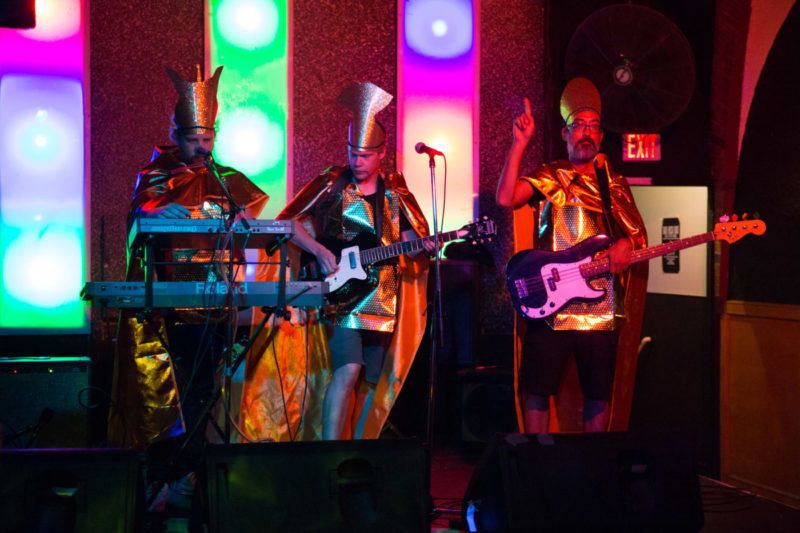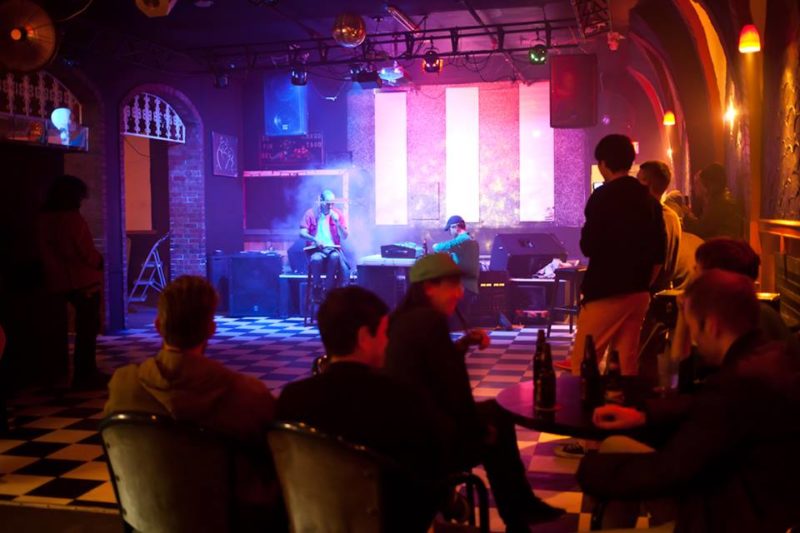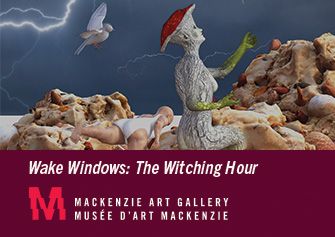In Praise of Unforeseen Circumstances: One year of ‘art rock?’
25 November 2016
By Daniel Colussi
For just over a year Vancouver based interdisciplinary artist, filmmaker and musician Casey Wei has produced a series of shows under the banner of art rock? Wei’s practice is primarily in film and video but she has also curated several site-specific projects that transform the character and use of communal space. For Toronto’s 2015 Images Festival, Wei was the first ever artist-in-residence at the Chinatown Centre Mall on Spadina Avenue. She activated the mall’s lower mezzanine with ballroom dancing, mahjong tables, karaoke and live music, the kind of activities reflective of the demographics of mall’s primary users, who are for the most part Chinese and elderly. For the course of that week, Wei virtually never left the confines of the mall, during the day she hosted and documented the lower mezzanine and at night she had in a room in the Super 8 hotel attached to the mall.
Wei’s film Kingsgate Mall Happenings was screened as part of the Images Festival, and this film chronicled an earlier and similarly-minded shopping mall project that took place in Vancouver the previous summer. Acting as the Western Front’s artist-in-residence in June 2014, Wei organized a month of open-ended ‘happenings’ to take place at the mall—live music, tarot readings, a talk show, live portraits, poetry readings, an open mic, and a flea market respectively—which she documented through videos and a tumblr site. The Western Front is an internationally respected artist-run-centre known for its interdisciplinary programming that runs from poetry readings and exhibitions to new music and other performances; Kingsgate is a ragged shopping mall that’s scheduled to be torn down to make way for another condo development. Though they’re only a few blocks away from each other, they also couldn’t be further apart, and Wei’s Kingsgate Mall Happenings effectively brought them together. Although the project was meant to last all month the plug was pulled abruptly after only two weeks, the official cause being “unforeseen circumstances.” But weren’t unforeseen circumstances what Kingsgate Mall Happenings was meant for?
What I found immediately appealing about art rock? is that it offers no easy or clear definition of itself. The question mark in its name begs these questions. Is it bands? Video projections? Sound-art? Comedy? I got the impression that a lot of the bands weren’t bands per se but something else, more like fugitive performances played out on the stage, or better yet, in that undefined space on the floor in front of the stage. The fact that art rock? takes place at the Astoria on East Hastings presents another idea of undefined space. It’s is a bar that’s managed to resist the wave of condo developments submerging Vancouver. You can still go to the Astoria and see metal bands, dance hall parties, karaoke, and a monthly amateur stripper competition. Amid this milieu, art rock? extends an open invitation: the audience is invited to see something unfold for what may be the first and also the last time; for performers it’s an opportunity to play-out some idea in the flesh without the burden of deciding if it’s a band or art, serious or unserious, real or make believe. Wei tags every poster with #popularesoteric, which we’ll say is the subversion of art via live rock music performance, the intellectual infiltration into rote rock norms by critical art practice.
Wei has noted her “ever present desire to generate more crossover between visual art and music,” and she’s by not the first in the city to feel this. I’m thinking of UJ3RK5, the late 70s conceptual punk rock band that included Vancouver School heavyweights Jeff Wall, Rodney Graham and Ian Wallace among others. UJ3RK5 were definitely #popularesoteric. The band came out of that same spirit of mutual subversion: visual artists crossing over into the noise, mess and urgency of live rock performance. UJ3RK5 didn’t last long: they played some shows, recorded one self-titled LP of tense and ridiculous punk rock (copies of which can be found floating in record bins at an exorbitant collector’s price) and then disbanded so that they could get on with their art careers. But for their short run they were able to celebrate in that same undefined space that I find in Wei’s art rock?
What is it that’s so appealing about artists picking up instruments? I think it has to do with the human-ness that’s brought into the performance. In his book Theatre of the Unimpressed Toronto playwright Jordan Tannahill observes that “in an age that touts high-performance perfection in everything from furnaces to cars to the circus,” perfection itself becomes fatiguing and failure becomes appealing. There’s real pleasure to be had in watching performances that “understand that failure is not merely the unwanted by-product of risk and experimentation but often the very nexus of a work’s humanity.”(1) Failure brings the audience into closer proximity to the performer. There’s an intimacy that’s shared when the music comes together at the same time that it’s about to fall apart. Sometimes failure should be part of the goal.
I corresponded with Wei over email about spaces, performances, and unforeseen circumstances.
Daniel Colussi: Tell me your impetus for starting art rock? I’m wondering how Kingsgate Mall Happenings framed the approach of the art rock? series and specifically what you wrote on the Kingsgate Mall Happenings tumblr: your “ever present desire to generate more crossover between visual art and music.”
Casey Wei: It happened after Nikki—she’s Astoria manager and she performs as Terrorbird/ Forms of Discipline—approached me to do a weekly night after the Kingsgate Happenings. I was pretty hesitant at first because Kingsgate was a pretty intense challenge, and you know how that ended. But after a bit of back-and-forth I decided to try to do it once a month, and came up with “art rock?” The question mark is important, because…what is it? Art, rock, art-rock…It’s so vague, it could mean a lot of things, approached from many perspectives and histories. The series would set out to explore possible answers. A “series for and inspired by the performers of sounds, visuals, and poetics.”
I’m pleased that the tumblr quote resonated. Music and art are categorically different, from economic and sensorial points of entry, but at the centre of it all they’re still expressing the same fundamental needs, desires, fears, critiques. It’s not quite the gesamtkunstwerk yet, but it’s getting closer.
I’m wondering about the space and the setting, The Astoria is a classic, sort’ve dirty East Vancouver punk/metal/rock bar. Was it just a pragmatic decision, or is there something particularly appealing about the Astoria?
Nikki at the Astoria asked me to do it there. That’s it. You can read into the lineage and histories of that, but it was pretty simple, she offered it, so I said yes. It’s classic and dirty, but it’s also very unique aesthetically. It has a weird costume party grotto vibe with those stucco walls and the funky lights, that tile floor, the strange division of the space by the ‘sound castle’ right in the middle of the room, a boxing ring downstairs, a tiny kitchen window right beside the stage lol. It’s small enough to be able to run a night there as one person (with the help of a few friends), and big enough for it to not feel claustrophobic.
Was there any consideration of doing these kinds of shows at a gallery space rather than a bar?
If an art gallery approached me to do something, then sure, of course I would. It would be very different from art rock? I’d think, because art rock? really got its identity from the space of the Astoria.
How do you pick the performers? What makes a particular band/performer/group appropriate for this series? What makes a performer an attractive pick to you?
Hmm…I guess I start with the people I know. I think the best musicians are artists. So it just makes sense to me to ask artists who I think are good to play the music that they are making anyway. Coming from a visual art background and being involved in the art community here over the years, I’ve seen a lot of stuff that makes it to the exhibition and that stuff that doesn’t. Many of the visual artists I know also play music, love music, but aren’t involved so much in the music scene because they don’t have the time to do both. So, art rock? has given them some kind of deadline to make something to perform. My only rule is that the set has to be at least 10 minutes long. Very low stress, but also motivating. It makes me really happy to be able to put a night on where more established band-bands (in the music scene) that I really love (Shearing Pinx, Gretchen Snakes, Swim Team, etc.) with new bands emerging from art rock? (Strawberry, Zenfinger, Kinda Green, etc.)
I’m interested in how you seek out that line between a rock band and art performance. When does a performance stop being “a rock band” and become something else, a performance informed by a critical art practice?
This is a hard one. There’s no way to really answer this because it’s so nuanced. I think the only way is to refer to what I said earlier about the best musicians being [visual] artists. How I define that is very idiosyncratic, and I wouldn’t be able to put it down in a checklist. There’s the understanding of the canon (and there are so many canons, just pick a genre, a decade, a color, an instrument, etc.) and then a reaction to it, and then something happens that makes it your own. It’s irreverent, but also embracing.
One night at an art rock? a few of us were standing outside, and someone told me how art rock? was so great because in the music scene, many bands do it because it’s fun and it’s cool (who doesn’t want to play music with their friends and evoke their favorite bands). But the stuff he saw at art rock? he felt was really unique. The performers were doing it in a more serious way. So maybe that: a seriousness, as some kind of reflexive introspection, that can be playful and fun too, but a seriousness. Someone who gets what the #popularesoteric is all about.
Every show is tagged with #popularesoteric, so tell me about the principle of #popularesoteric with regards to art rock?
The ‘popular esoteric’ is the idea of making the popular esoteric. Art is esoteric, rock is popular, so when combined there is a play and a subversion between the two…At their worst, visual art is often intellectualized and turnt up with academic philosophical jargon, and rock (popular) music sounds like branded garbage. So, the #popularesoteric is a way to qualify that nebulous question mark.
On the Kingsgate Mall Happenings tumblr you make a really nice reference to allowing for the possibility of failure. Tell me about that. What does the allowing for failure permit to happen?
I think Kingsgate Mall Happenings was framed as a failure in the end, but one that generated a lot of discussion, passion, [and] engagement. It was and it wasn’t a failure. I don’t see the art rock? series as having to do much with failure. To admit to failure is to be vulnerable, and to be vulnerable is to be human and to recognize our mortality. So my conception of art rock? has that sensitivity rippling through it. When you feel like you fail, it’s a feeling no one else can shake. I’m not glorifying or welcoming failure (I hate it, it feels awful) but the more you perform, the more comfortable you get with being on stage, and the less you question whether or not something was a ‘success’ or a ‘failure.’

Tell me about the crowd that’s turning out for art rock?
The crowd is a mix of people who are involved in visual art and music. Sometimes there are people from the neighborhood. Once an old guy sat near the entrance the whole time and yelled in my general direction while I was at the door, “This is art rock? I can’t listen to that.” But he stayed until the end of the night anyway.
art rock? has spanned just over a year. Should it keep going or should it end?
It’s not over. In the beginning, it was a really big learning curve for me (mostly juggling the stress of learning how to do sound with all the other logistical crap), so setting this finite timeline goal gave me some control over my stress. When it started, it was really just my ‘vision’ and I didn’t know how it would go once enacted in the space. Over the last year through these 12 episodes, I’ve learned how the nights flow, and how to relax and play things by ear. Each art rock? is video-documented and then I edit the footage into an episode [on YouTube]. I always thought it would be super cool to have a public access show like the stuff on Winnipeg Babysitter, TV Party, or the Scott and Gary Show, but living in the YouTube age, a web show will do just fine. So, just as the year is ending, I finally feel relaxed enough to enjoy it.
Agony Klub (my music and printed matter label) has come out of art rock? In issue 1’s letter from the editor, I write: “Agony Klub Records and Books is a material extension of the art rock? series that I have been curating at the Astoria Pub.”
Agony Klub comes from that framework in which exploration and experimentation of the popular-esoteric is the criteria, it is not a space of comfort. The investment is agonizing and sometimes pretty out-there, but at the same time, all of us involved practice a level of critical distance that allows for the containment of that unknown through songs, words, sounds, noise. Art rock? is live, intense, a bit messy but safe; somewhere between the studio space and the spectacle. Agony Klub is the concentrated effort of that energy, put into material form.
I’m excited about that crossover—having art rock? as a place where things manifest themselves into Agony Klub, and then having Agony Klub as a place where music, art, and writing can all meet together and make something beautiful and sharp and with much [more] depth.
There’s still lots I want to do. Having visuals and some kind of props and installation[s] would be great. The fog machine at the Astoria sometimes works, sometimes doesn’t. Of course, there is yet to be any budget for these nights, so we’re operating with limited means. But I like that too, there’s really no glitz or glamour or posturing here. Everything is raw, makeshift, scrappy and bold.
- Tannahill, Jordan. Theatre of the Unimpressed: In Search of Vital Drama. (Toronto: Coach: House Books, 2015), 115-117.
Featured image of art rock? no. 2, October 13, 2015 by Lukas Englehardt.



